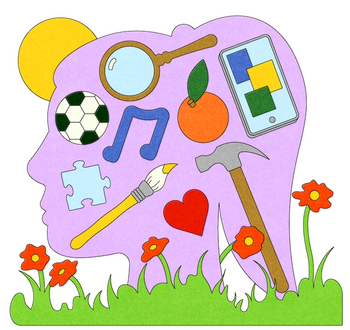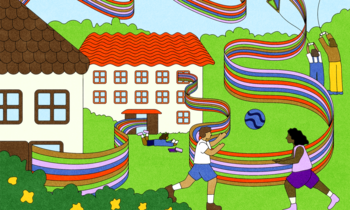Embedded in the proverb “it takes a village to raise a child” is a profound truth: The collective effort of an entire community is essential for nurturing the growth and well-being of children.
This understanding resonates throughout the family-school-community partnerships framework, which operates as a dynamic cycle and embraces the role of parents and caregivers as bridges – linking families to other families, families to educators, and families to communities in a shared endeavor. Within this framework lies a vast reservoir of potential, often overlooked and underutilized yet pivotal in propelling student success, nurturing social responsibility and fostering advocacy. The symbiotic relationship between community support and individual growth forms the basis of holistic development for the whole child. (“Family” in this context is defined inclusively and might encompass parents and caregivers, family members, foster families and all who identify as chosen family.)
A Liberatory, Whole-Child Approach
In essence, holistic child development, as emphasized in a report from Porticus, lies in cultivating well-rounded individuals who are academically proficient, socially and emotionally competent, physically healthy and ethically responsible members of society. Understanding the whole child deepens the interconnectedness of environment, experience and community. The Learning Policy Institute highlights how students’ educational outcomes are influenced by their surroundings, emphasizing the key role of safe and nurturing learning environments with rich experiences, both within and beyond schools.
Similarly, rather than focusing solely on academic achievement or cognitive development, liberation recognizes that children are multifaceted beings with diverse needs and abilities. A liberatory approach recognizes and confronts the political, social and economic barriers to development and seeks to build capacity and strategies for systems change. This approach requires a fundamental change in one’s heart and mind to value individuals in their current contexts and to rebuild systems and services to support communities in reaching their collective aspirations and expectations. By acknowledging the disparities in student development outcomes based on geographic location – recognizing a child’s ZIP code as a potential limitation – stakeholders in a child’s growth journey are challenged to cultivate partnerships aimed at nurturing growth. We cannot wait for policy change; we have to change circumstances programmatically.
One parent eloquently expressed the sentiment underlying this liberatory, whole-child approach: “We need more people to give us permission to be a village, to be a community. You are more valuable than your circumstances. If no one shows you, you are left to learn on your own. And if you don’t have the tools to learn a thing, you soak in shame. Sometimes shame is more difficult than the circumstance.” This underscores the importance of fostering supportive and inclusive community environments in which every individual is recognized for their inherent worth and empowered to contribute to the collective well being of the village.
The Children’s Defense Fund (CDF) Freedom Schools® provide summer and after-school programs through a research-based and multicultural program model to foster holistic child development that supports children, youth and their families through five essential components: high-quality academic and character-building enrichment; parent and family involvement; civic engagement and social action; intergenerational servant leadership development; and nutrition, health and mental health. Within the program, children and youth are referred to as “scholars.”
Many CDF Freedom Schools sites incorporate a liberatory culture of engagement that embraces family-school-community partnerships. This approach empowers all stakeholders in community-building activities: orienting each person and child to the program’s village, establishing clear expectations, creating safe spaces for children and adults alike, fostering consistent communication, incorporating restorative practices and concluding our village experience in celebration.
Five components of holistic development inform a liberatory partnership framework:

- Physical development encompasses growth, honing motor skills and coordination, and engaging in activities that contribute to overall physical health and well-being.
- Social development fosters interactions with others, nurturing social skills, empathy and cooperation. This facilitates the establishment of positive relationships within family, peer groups and the broader community.
- Intellectual development pertains to cognitive advancement, encompassing thinking, reasoning, problem- solving and the acquisition of new knowledge.
- Emotional development entails nurturing the ability to understand and regulate emotions, fostering independence, resilience and the cultivation of healthy relationships.
- Spiritual development involves the formulation of personal values, moral principles and identity. It entails supporting the development of children’s personality, beliefs and sense of purpose from an early age.
By embracing holistic development, stakeholders recognize that children thrive in environments that provide for their diverse needs and abilities. A true partnership becomes a village, requiring stronger relationships, support networks and resource distribution across communities.
From Partnerships to Village
A liberatory approach to family-school-community partnerships cultivates a culture of engagement that welcomes all children, families and community members – forming a cohesive village.
Partnerships involve mutual commitment and collaboration to achieve objectives or to address challenges. They foster innovation, cooperative action and sustainability by combining diverse perspectives, skills and resources to have greater impact than individual efforts. They also promote shared accountability and responsibility, leading to more comprehensive solutions to complex problems.
A liberatory approach to family-school-community partnerships cultivates a culture of engagement that welcomes all children, families and community members – forming a cohesive village. Parents and caregivers support one another and serve as co-educators and community advocates in collaboration with children, school and community. Essentially, families become as integral to the school as the institution itself is integral to the community. Some of the benefits of this collaboration are improved academic outcomes, enhanced social and emotional support, healthier school environments and neighborhoods, and strengthened community ties.
The village, as envisioned in this model, strives to unite rather than divide families, educators, and other community members and organizations, thereby fostering a sense of collective purpose and shared responsibility for the welfare of our children. According to researcher Jay L. Lemke, a child’s growth journey is intricately shaped by the environment in which they grow and develop. This environment, however, is not a standalone entity but rather a product of the systems created by individuals and groups. It is characterized by the contributions of caring adults, diverse experiences, educational opportunities and social interactions, all of which play a pivotal role in shaping a child’s identity within the community and broader society. Lemke refers to these elements as “village activities.”
Conversations with families, educators and community members in the CDF Freedom Schools program make evident that the concept of a village extends beyond parental roles. As one parent says, “The burden is on everyone, not just the teachers and parents but the neighbor and store owner.” The collective responsibility is shared by all members of society.
Being a village entails meeting basic needs and providing love, accountability, education and other essential elements that contribute to children’s well-being. It entails recognizing the interconnectedness of individuals. The village is a way of being that benefits the entire community – a whole child, a whole parent, a whole school and a whole community – with a focus on nurturing future generations.
Strategies for Effective Collaboration and Partnerships
Cultivating partnerships within the educational and development communities requires creating inclusive environments that prioritize collaboration. Strategies for fostering collaboration involve embracing the contributions of families and leveraging the diverse strengths of all stakeholders.
Consider the following recommendations for partnerships:
- Encourage parental and caregiver involvement. Shift thinking from a limited idea of what a good parent looks, sounds and thinks like – which often is rooted in white Eurocentric ideologies – to creating an inclusive environment, ready to receive what families have to offer and to support families in achieving shared goals.
- Foster open communication channels among parents and caregivers, educators, and school administrators, and recognize families as valuable sources of insight, expertise and support.
- Build trust and mutual respect among stakeholders. Say what you mean and mean what you say. At the beginning of the relationship, set clear expectations and keep communication consistent. Offer continuous shared learning and growth to address challenges head-on using restorative practices.
- Leverage technology for communication and engagement. Technology is advancing every day in providing users with tools for connection, information, entertainment, access and more.
- Co-develop and implement joint initiatives and programs, with active involvement from families, who contribute valuable resources and support to enhance partnerships.
- Encourage inclusive decision- making that honors the perspectives and contributions of all stakeholders.
- Equitably provide (and invite) family resources and support to help all stakeholders realize their power to enrich the community’s collaborative efforts.
- Promote cultural sensitivity and diversity awareness. Identify and develop a praxis that reflects and affirms the values and worldviews of Black and other people of color as well as other historically marginalized groups such as LGBTQ+ families and people with disabilities.

When parents and caregivers are recognized as partners in their children’s education and community endeavors, they can realize their power to play active roles in shaping the learning environment and fostering a thriving community.
Family-school-community partnerships can take many forms, including community meet-and- greets with job candidates for education positions; community resource and uniform drives to ensure every child feels confident and prepared for school; family entrepreneurial initiatives, in which families share their talents with the community; and community reading groups.
A good example is Harambee, which happens within the first 30 minutes of the CDF Freedom Schools’ daily programming. “Harambee” is a Swahili word that means “let’s pull together,” reflecting the spirit of unity and collaboration cherished by the community. During Harambee, parents, caregivers and other members from the village are invited to serve as read-aloud guests. The goal is to inspire scholars to love reading, both in school and at home. These read-alouds are followed by Q&A sessions that provide opportunities for scholars to ask parents and caregivers questions. Scholars benefit from the exposure to diverse stories and role models, fostering a lifelong love of reading. Families have a positive opportunity to engage with individuals working at the site while also contributing to their scholars’ educational journey. And site-based educators receive support in their work toward making reading a treasured activity.
A Call to Engage All Families
Celebrating the village as a proactive choice ensures the well-being of all children and affirms the transformative power of partnerships in nurturing the next generation. We each have the power to accept our role in a village.
As a Black woman who grew up in a Black single-headed household with three Black siblings in an anti-Black world, I can attest to the alienation experienced by Black parents and caregivers in working with public institutions. Family- school-community partnerships have a profound ability to liberate us from limiting or discriminatory roles and responsibilities, not only for school engagement but also for the well-being of all members – especially those from historically marginalized communities.
Too often, educators overlook the wealth of knowledge and skills families offer. However, in CDF Freedom Schools, parents and caregivers are recognized for their multifaceted identities. Within our village, they actively contribute their talents, hobbies and professional skill sets to various aspects of teaching and learning, organizational development, advocacy, parent programming and more. This liberatory approach enriches the educational experience and strengthens the bonds within our community.
In the absence of the village, we function as silos: at home, at school and in community. If we truly desire strong partnerships in education, we must center the needs of children and actively engage parents, caregivers and families. The family-school- community partnership serves as the village – a collaborative endeavor encompassing the entire community’s commitment to all children.
Celebrating the village as a proactive choice ensures the well-being of all children and affirms the transformative power of partnerships in nurturing the next generation. We each have the power to accept our role in a village.
